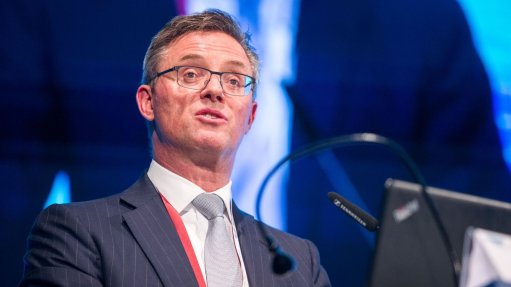World Bank says Eskom debt restructuring should be coupled to power market reform

World Bank country director Paul Noumba Um on restructuring of Eskom and the need for power-market reform. Camera Work & Editing: Darlene Creamer
World Bank country director Paul Noumba Um believes the South African government is moving in the “right direction” by pursuing discussions on possible debt relief for Eskom in conjunction with plans for restructuring the utility and overhauling the architecture of the domestic power market.
He also argues, however, that Eskom’s restructuring should form part of a broader reform agenda for all State-owned companies (SoCs), which were no longer delivering returns and had, instead, become liabilities.
The bank has a direct interest in the fortunes of Eskom having advanced a $3.75-billion loan to Eskom in 2010 to help fund the Medupi coal-fired power station project in Limpopo, as well as several other projects.
Describing Eskom as “too big to fail”, Noumba Um argued this week the way forward would require “different kinds of interventions”, including efficiency improvements at the utility, which may involve retrenchments, as well as power-market reform.
“Having Eskom as an integrated, dominant provider of power . . . has been an asset for South Africa.
“But if you want it to remain an asset for South Africa going forward, you also need to pay attention to the transition to clean energy, which is happening at the same time.
“So, reorganising that market is critically important and making sure that each part of that market plays its role is also critically important.”
The bank’s remarks came amid confirmation that the Eskom Sustainability Task Team, appointed by President Cyril Ramaphosa in December, had delivered a briefing at the recent African National Congress (ANC) lekgotla.
Business Day reports that the task team outlined a proposal for splitting Eskom into three State-owned companies for generation, transmission and distribution.
The proposal reportedly received a mixed response and, in its post-lekgotla statement, the ANC said government had been requested to “consult with all stakeholders, particularly with trade unions, within the coming three weeks, on these recommendations and other proposals”.
No mention was made in the statement of the debt restructuring options, including reports that the National Treasury would consider transferring to the fiscus about R100-billion-worth of Eskom debt already guaranteed by government.
Noumba Um suggested that any debt restructuring would have to be assessed in light of the guarantees extended by government to Eskom, which meant, “if Eskom cannot pay, government will have to pay”.
CONTINGENT-LIABILITY SHOCK
The bank recently published a discussion paper on the potential for a “materialisation” of SoC contingent liabilities and the effect a potential shock could have on fiscal policy.
The scenarios outlined in the paper indicate that debt as a percentage of gross domestic product (GDP) could increase by between 1.2% and 2.1% of GDP within three years, compared to the baseline projection. In other words, in the event of a contingent-liability shock, South Africa’s debt-to-GDP ratio could reach between 57.1% and 58% in 2020 compared with the baseline projection of 56%.
“Although the increase of the debt-to-GDP ratio is not large according to the two scenarios of contingent liabilities, what is most concerning is that the debt level as a share of GDP has a tendency of growing further and will be harder to stabilise, compared to the baseline projection where debt stabilises,” the discussion paper states.
It adds that the losses incurred from the contingent liabilities may also become significant driving factors of debt accumulation in medium term.
The paper diverges, however, from the contingent-liability shock scenario simulated in the July 2017 Article IV, published by the International Monetary Fund. In that assessment, the size of the contingent-liability shock is imposed as R610.4-billion, or 12.3% of GDP, in a single year.
The World Bank argues that such a shock is not realistic, as it assumes that SoCs will go bankrupt and creditors will accelerate all liabilities. Instead, the bank assumes that government will step in to undertake periodic debt-service payments if entities are in distress, rather than allowing entities to fail.
Nevertheless, Noumba Um argued that a comprehensive approach should be adopted for all the SoC contingent liabilities, including Eskom, which makes up more than 70% of current contingent liabilities.
He expressed optimism that government would adopt a broad-based reform agenda. “I think that the debate that is taking place now is really going in the right direction, because all the considerations are being looked into.”
Comments
Press Office
Announcements
What's On
Subscribe to improve your user experience...
Option 1 (equivalent of R125 a month):
Receive a weekly copy of Creamer Media's Engineering News & Mining Weekly magazine
(print copy for those in South Africa and e-magazine for those outside of South Africa)
Receive daily email newsletters
Access to full search results
Access archive of magazine back copies
Access to Projects in Progress
Access to ONE Research Report of your choice in PDF format
Option 2 (equivalent of R375 a month):
All benefits from Option 1
PLUS
Access to Creamer Media's Research Channel Africa for ALL Research Reports, in PDF format, on various industrial and mining sectors
including Electricity; Water; Energy Transition; Hydrogen; Roads, Rail and Ports; Coal; Gold; Platinum; Battery Metals; etc.
Already a subscriber?
Forgotten your password?
Receive weekly copy of Creamer Media's Engineering News & Mining Weekly magazine (print copy for those in South Africa and e-magazine for those outside of South Africa)
➕
Recieve daily email newsletters
➕
Access to full search results
➕
Access archive of magazine back copies
➕
Access to Projects in Progress
➕
Access to ONE Research Report of your choice in PDF format
RESEARCH CHANNEL AFRICA
R4500 (equivalent of R375 a month)
SUBSCRIBEAll benefits from Option 1
➕
Access to Creamer Media's Research Channel Africa for ALL Research Reports on various industrial and mining sectors, in PDF format, including on:
Electricity
➕
Water
➕
Energy Transition
➕
Hydrogen
➕
Roads, Rail and Ports
➕
Coal
➕
Gold
➕
Platinum
➕
Battery Metals
➕
etc.
Receive all benefits from Option 1 or Option 2 delivered to numerous people at your company
➕
Multiple User names and Passwords for simultaneous log-ins
➕
Intranet integration access to all in your organisation



















